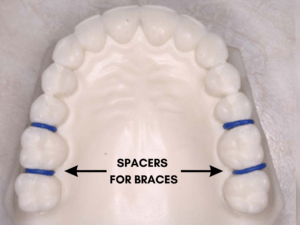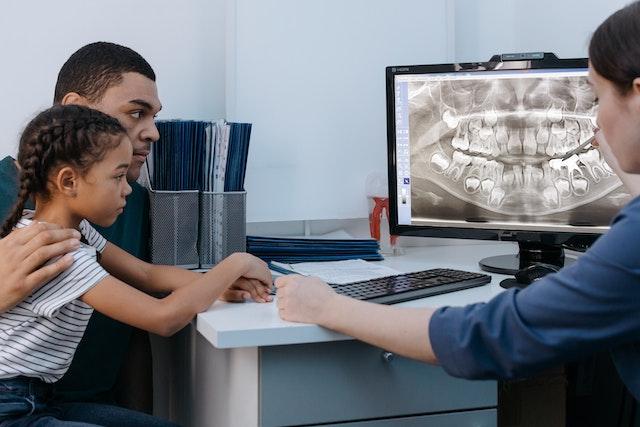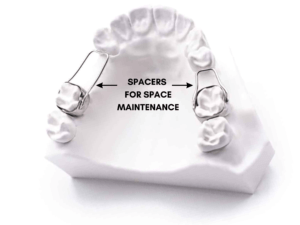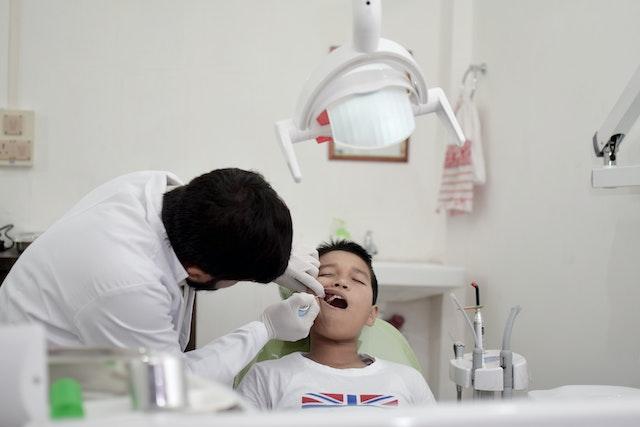What do Spacers for Children's Teeth do?
Spacers for children’s teeth are separated into two types of dental treatments. One is used primarily with orthodontics during the course of braces or in preparation for braces. The other type of spacer is used to hold space for the adult teeth to grow in.
In this article, we’ll break down all the uses of spacers for children’s teeth and how they can benefit your child’s smile. We will also go over why they are necessary to maintain your child’s oral health and what to expect during the dental appointment.
Table of Contents
The 2 Types of Spacers for Children's Teeth
The main point of all spacers for children’s teeth is to provide space maintenance for permanent adult teeth. They are influential in the alignment of the adult teeth to improve your child’s smile. The two main types of spacers for children’s teeth are used as part of orthodontic treatment and by space saving for adult teeth.
Orthodontic Spacers for Children's Teeth

Spacers for children’s teeth are small devices used in orthodontics to create space between teeth prior to the placement of braces. They are typically made of rubber or metal and are placed between the molars to help separate them and make room for other teeth to be moved into proper alignment.
They are typically worn for a week or two before the braces are placed. The spacers create a slight pressure on the teeth so mild discomfort may be present. Many people say it feels like food is stuck in between the teeth at first but then they get used to the feeling.
For more information on braces, check out our articles below.
Why Do They Put Spacers In Your Teeth For Braces?

Spacers are used to create a small amount of space between the molars so that orthodontic bands can be placed around them during the placement of braces. The bands are where the wire feeds into and stabilizes it. Bands are usually placed on the first molar and are made out of metal.
Without creating this small space around the molars, the bands would not fit properly. It is also important for the braces to be stabilized in the bands to exert the necessary force to move the teeth into the correct position. Additionally, spacers can also be used to create room for teeth that have not yet erupted or to move teeth that are too close together.
Caring for Orthodontic Spacers for Children's Teeth
Since these temporary spaces are only secured by wedging them between teeth, they can become dislodged easily. It’s important to encourage your child to leave the spacers alone and not push on them with their tongue or fingers.
Caring for orthodontic spacers includes:
- Brush gently around the spacers. You may want to turn your electric toothbrush off when brushing the area.
- Do not floss between these teeth until your orthodontist removes the spacers. Flossing will dislodge the spacers for children’s teeth.
- Do not use flossers, toothpicks, water flossers, or other interdental tools.
Spacers for Teeth - What to Eat?
Certain foods can cause the spacers for children’s teeth to shift or fall out. You should not chew gums or tacky mints with spacers. You should also avoid sticky foods and candies like dried fruits, gummies, taffy, and caramels. Foods that get stuck in between the teeth should also be avoided because you cannot use floss around the spacers.
If you have mild discomfort after the placement of spacers, stick to soft foods until the sensitivity decreases. These foods can include soups, yogurt, pasta, mashed potatoes, and other softer foods. Cooler foods may also provide some relief after the spacers are initially replaced.
Space Maintenance Spacers for Children's Teeth

Early childhood cavities are one of the most common chronic diseases among young children. That’s right, the dramatic increase of cavities in kids is now a chronic disease. Many times, these teeth with cavities will have to be extracted before those teeth are intended to fall out naturally.
Baby teeth play an important role in saving space for adult teeth. When these baby teeth have to be removed before they were ready to fall out naturally, the space isn’t being saved for the adult tooth. That’s where spacers for children’s teeth are needed for space maintenance.
Check out our How to Avoid Cavities in Kids article for more information.
Spacers For Teeth After Extraction
After tooth extraction, spacers may be used to preserve the space left by the extracted tooth. Baby and adult teeth like to touch. The absence of a neighboring tooth will cause shifting that will close off the space. Maintaining the space also is important to prevent bite problems, aesthetic issues, and difficulty with future dental work.
This is particularly important in cases where the extracted tooth is a permanent tooth that will be replaced with an implant or a bridge. The spacers can be used for a few weeks before the implant or bridge is placed to ensure that there is enough space for the replacement tooth.
Check out our Guide to Teeth Erupting for a timeline of when baby teeth should fall out and adult teeth should grow in.
What to Expect with Spacers for Space Maintenance

These types of spacers for children’s teeth are made out of metal and are glued to the tooth by your dentist. They have a metal band that goes around the tooth with rounded metal bars to prevent teeth from leaning into the space.
Your dentist will first take a mold or digital scan of the teeth to make a customized spacer. The teeth do not typically need to be numbed for this procedure. There may be mild discomfort with the gums until they adjust. These types of spacers for children’s teeth will be removed once the adult teeth start to erupt through the gums.
Good oral hygiene is important with these types of spacers for children’s teeth. Food can get stuck under the bars and increase the risk of cavities. Brushing 2 times a day for 2 minutes and flossing around the bar are important to remove food, plaque, and bacteria daily.
Spacers for Teeth - What to Eat?
These types of spacers are held in the mouth by special glue that fixes the appliance to the teeth. If not taken care of properly, the space maintainer can become dislodged and fall out. It’s important to avoid any sticky foods that may pull the spacer off.
After the initial placement of the spacer, some minor discomfort is common from the gums. Stick to soft foods until the sensitivity decreases. These foods can include soups, yogurt, pasta, mashed potatoes, and other softer foods. Cooler foods may also provide some relief after the spacers are initially replaced.
How Much Do Spacers for Teeth Cost?
The cost of spacers for teeth can vary depending on the type of spacer for children’s teeth. Spacers used as part of orthodontic treatment prior to braces are usually included in the total braces fee and are not an added cost. The cost of this type of spacer is very little and is very quick to place in the mouth.
Spacers for space maintenance can be costly depending on how many teeth are involved. They usually take two appointments, one to take an impression or scan of the teeth and another to place in the mouth. Many times, the scan or impression of the teeth is sent to a lab in order to create the custom-fit spacer.
On average, a traditional metal spacer for space maintenance can cost between $75 to $200 per area. The price may be higher if more space is needed to maintain. The cost of spacers may be covered by dental insurance in certain cases, but it’s best to check with your insurance provider for more information about your coverage.
Frequently Asked Questions
Do kids need spacers in teeth?
In most cases, spacers are necessary to maintain and improve your child’s oral health. Spacers for braces are needed to place the bands on the molars. Space maintainers are important to allow the adult teeth to come in. If a tooth doesn’t have enough room to push through, it can stay in the bone and become a problem.
Are space maintainers painful?
Space maintainers may cause minor discomfort on the gums until they adjust. This is especially true if the gums are not healthy prior to the placement of space maintainers. Thankfully, the gums usually adjust quickly with good oral hygiene.
Take Home Smile Store
Visit our Take Home Smile store for educational brochures and other fun printables to help with oral hygiene. All products can be customized to fit your dental needs.



